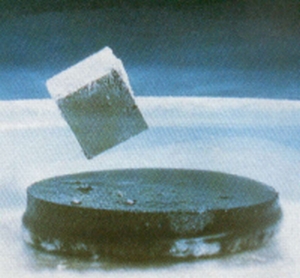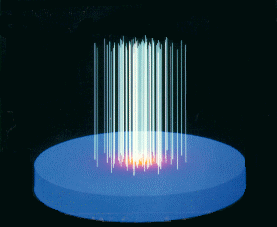Physics
By danimarco
@danimarco (216)
Romania
4 responses
@smbilalshah (1316)
• Pakistan
8 Feb 07
Superconductivity, discovered in 1911 by Heike Kamerlingh Onnes, is a phenomenon occurring in certain materials at extremely low temperatures (on the order of negative 200 degrees Celsius), characterized by exactly zero electrical resistance and the exclusion of the interior magnetic field (the Meissner effect).
The electrical resistivity of a metallic conductor decreases gradually as the temperature is lowered. However, in ordinary conductors such as copper and silver, impurities and other defects impose a lower limit. Even near absolute zero a real sample of copper shows a non-zero resistance.
The resistance of a superconductor, on the other hand, drops abruptly to zero when the material is cooled below its "critical temperature", typically 20 kelvins or less. An electrical current flowing in a loop of superconducting wire can persist indefinitely with no power source. Like ferromagnetism and atomic spectral lines, superconductivity is a quantum mechanical phenomenon. It cannot be understood simply as the idealization of "perfect conductivity" in classical physics.
Superconductivity occurs in a wide variety of materials, including simple elements like tin and aluminium, various metallic alloys and some heavily-doped semiconductors. Superconductivity does not occur in noble metals like gold and silver, nor in most ferromagnetic metals.
In 1986 the discovery of a family of cuprate-perovskite ceramic materials known as high-temperature superconductors, with critical temperatures in excess of 90 kelvins, spurred renewed interest and research in superconductivity for several reasons. As a topic of pure research, these materials represented a new phenomenon not explained by the current theory. And, because the superconducting state persists up to more manageable temperatures, more commercial applications are feasible, especially if materials with even higher critical temperatures could be discovered.
Meissner effect
When a superconductor is placed in a weak external magnetic field H, the field penetrates the superconductor for only a short distance ?, called the penetration depth, after which it decays rapidly to zero. This is called the Meissner effect, and is a defining characteristic of superconductivity. For most superconductors, the penetration depth is on the order of 100 nm.
The Meissner effect is sometimes confused with the kind of diamagnetism one would expect in a perfect electrical conductor: according to Lenz's law, when a changing magnetic field is applied to a conductor, it will induce an electrical current in the conductor that creates an opposing magnetic field. In a perfect conductor, an arbitrarily large current can be induced, and the resulting magnetic field exactly cancels the applied field.
The Meissner effect is distinct from this because a superconductor expels all magnetic fields, not just those that are changing. Suppose we have a material in its normal state, containing a constant internal magnetic field. When the material is cooled below the critical temperature, we would observe the abrupt expulsion of the internal magnetic field, which we would not expect based on Lenz's law.
The Meissner effect was explained by London and London, who showed that the electromagnetic free energy in a superconductor is minimized provided
where H is the magnetic field and ? is the penetration depth.
This equation, which is known as the London equation, predicts that the magnetic field in a superconductor decays exponentially from whatever value it possesses at the surface.
The Meissner effect breaks down when the applied magnetic field is too large. Superconductors can be divided into two classes according to how this breakdown occurs. In Type I superconductors, superconductivity is abruptly destroyed when the strength of the applied field rises above a critical value Hc. Depending on the geometry of the sample, one may obtain an intermediate state consisting of regions of normal material carrying a magnetic field mixed with regions of superconducting material containing no field. In Type II superconductors, raising the applied field past a critical value Hc1 leads to a mixed state in which an increasing amount of magnetic flux penetrates the material, but there remains no resistance to the flow of electrical current as long as the current is not too large. At a second critical field strength Hc2, superconductivity is destroyed. The mixed state is actually caused by vortices in the electronic superfluid, sometimes called fluxons because the flux carried by these vortices is quantized. Most pure elemental superconductors (except niobium, technetium, vanadium and carbon nanotubes) are Type I, while almost all impure and compound superconductors are Type II.
Theories of superconductivity
Since the discovery of superconductivity, great efforts have been devoted to finding out how and why it works. During the 1950s, theoretical condensed matter physicists arrived at a solid understanding of "conventional" superconductivity, through a pair of remarkable and important theories: the phenomenological Ginzburg-Landau theory (1950) and the microscopic BCS theory (1957). Generalizations of these theories form the basis for understanding the closely related phenomenon of superfluidity (because they fall into the Lambda transition universality class), but the extent to which similar generalizations can be applied to unconventional superconductors as well is still controversial.
@danimarco (216)
• Romania
22 Feb 07
Thnks for the introduction in superconductivity and superconductors clasification. is a verry good response for understanding the base of superconductivity.
@dhigambaram (1132)
• India
7 Feb 07
Its a parts of electronics nd physics .wot do u want to knw ......











